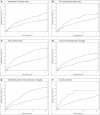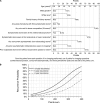The ROKS nomogram for predicting a second symptomatic stone episode
- PMID: 25104803
- PMCID: PMC4243346
- DOI: 10.1681/ASN.2013091011
The ROKS nomogram for predicting a second symptomatic stone episode
Abstract
Most patients with first-time kidney stones undergo limited evaluations, and few receive preventive therapy. A prediction tool for the risk of a second kidney stone episode is needed to optimize treatment strategies. We identified adult first-time symptomatic stone formers residing in Olmsted County, Minnesota, from 1984 to 2003 and manually reviewed their linked comprehensive medical records through the Rochester Epidemiology Project. Clinical characteristics in the medical record before or up to 90 days after the first stone episode were evaluated as predictors for symptomatic recurrence. A nomogram was developed from a multivariable model based on these characteristics. There were 2239 first-time adult kidney stone formers with evidence of a passed, obstructing, or infected stone causing pain or gross hematuria. Symptomatic recurrence occurred in 707 of these stone formers through 2012 (recurrence rates at 2, 5, 10, and 15 years were 11%, 20%, 31%, and 39%, respectively). A parsimonious model had the following risk factors for recurrence: younger age, male sex, white race, family history of stones, prior asymptomatic stone on imaging, prior suspected stone episode, gross hematuria, nonobstructing (asymptomatic) stone on imaging, symptomatic renal pelvic or lower-pole stone on imaging, no ureterovesicular junction stone on imaging, and uric acid stone composition. Ten-year recurrence rates varied from 12% to 56% between the first and fifth quintiles of nomogram score. The Recurrence of Kidney Stone nomogram identifies kidney stone formers at greatest risk for a second symptomatic episode. Such individuals may benefit from medical intervention and be good candidates for prevention trials.
Copyright © 2014 by the American Society of Nephrology.
Figures


Comment in
-
A nomogram for the prediction of kidney stone recurrence.J Am Soc Nephrol. 2014 Dec;25(12):2685-7. doi: 10.1681/ASN.2014060631. Epub 2014 Aug 7. J Am Soc Nephrol. 2014. PMID: 25104802 Free PMC article. No abstract available.
-
Stones: ROKS can predict recurrence.Nat Rev Urol. 2014 Oct;11(10):542. doi: 10.1038/nrurol.2014.237. Epub 2014 Sep 2. Nat Rev Urol. 2014. PMID: 25179498 No abstract available.
-
Re: The ROKS nomogram for predicting a second symptomatic stone episode.J Urol. 2015 Jun;193(6):2009. doi: 10.1016/j.juro.2015.03.035. Epub 2015 Mar 17. J Urol. 2015. PMID: 25986802 No abstract available.
References
-
- Parks JH, Coe FL: An increasing number of calcium oxalate stone events worsens treatment outcome. Kidney Int 45: 1722–1730, 1994 - PubMed
-
- Khedr MS, Abdel-Hamid AS, Feldman HI: Risk factors of stone recurrence in idiopathic renal calculi. Suez Canal Univ Med J 3: 41–48, 2000
Publication types
MeSH terms
Grants and funding
LinkOut - more resources
Full Text Sources
Other Literature Sources
Medical

